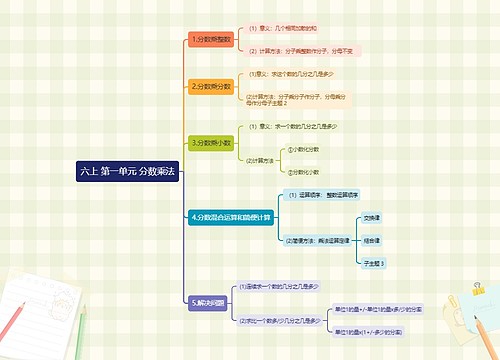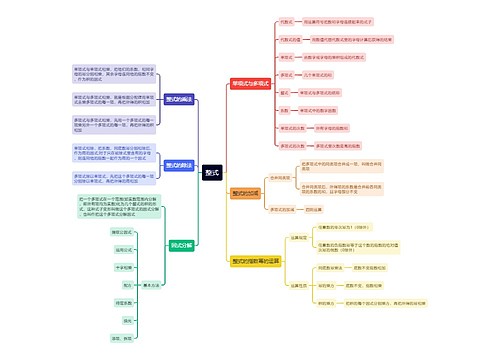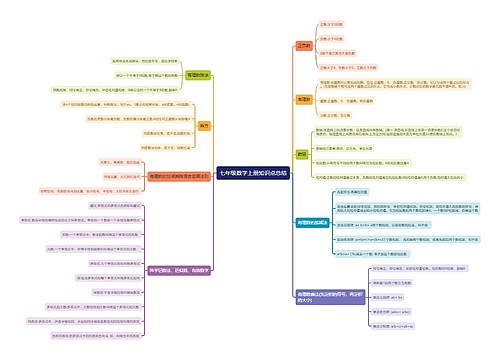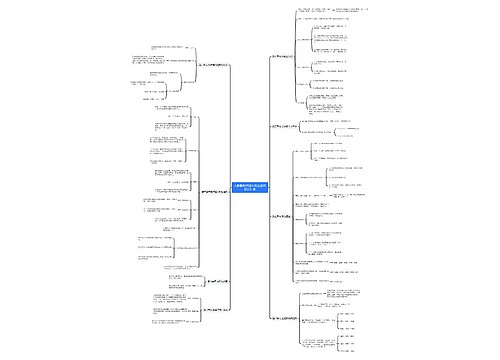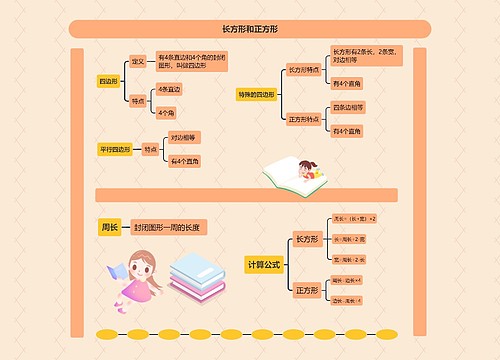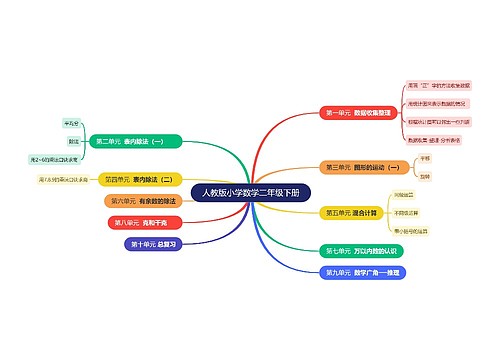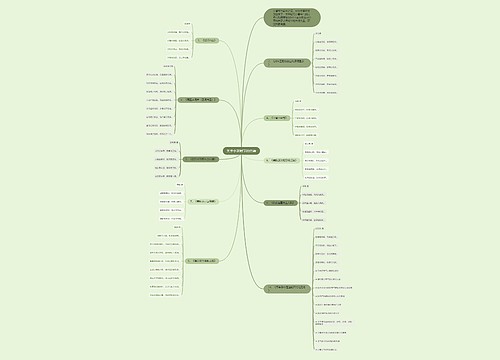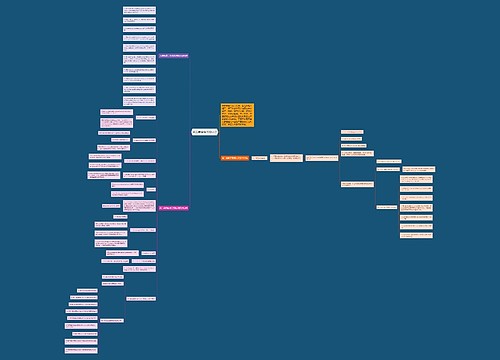
英语考试听力解题技巧方法思维导图
拾人心
2023-04-04

英语听力解题方法
英语听力解题技巧
英语
听力
解题
技巧
英语听力测试主要是考查学生理解口头英语的能力,确切地说,就是要求考生能够听懂日常生活中简短而地道的会话和独白。
树图思维导图提供《英语考试听力解题技巧方法》在线思维导图免费制作,点击“编辑”按钮,可对《英语考试听力解题技巧方法》进行在线思维导图编辑,本思维导图属于思维导图模板主题,文件编号是:b5e4ca3641d86d8ee3234ab4cbd2ec3b
思维导图大纲
相关思维导图模版
英语考试听力解题技巧方法思维导图模板大纲
英语听力测试主要是考查学生理解口头英语的能力,确切地说,就是要求考生能够听懂日常生活中简短而地道的会话和独白。下面是树图网为大家整理的关于英语考试听力解题技巧,希望对您有所帮助!
英语听力答题技巧
一、学会预测
预测是在做听力理解之前根据各种暗示,如所给答案选项,段落或对话标题等已有知识,对即将听到的段落或对话内容进行预测。
1. 从答案选项中预测:
Q: What does Tom do? A. He’s a truck driver. B. He’s a ship captain. C. He’s a pilot.
录音原文: W: Tom flew to Anchorage last night, then took some passengers from there to Dallas . M: Yeah, but he couldn't land because the airport in Dallas was snowed in. 从选项看,问题应是关于职业方面的,再从flew, passengers, airport这些信息词中可知道Tom的职业。
2. 从说话人口气预测:
在A,B两人的对话中,如果B是附和或赞成,往往说"Yes","I agree","Sure","I think so"等。但如A用否定句,B表同意时则用"No","Neither / Nor?"等。
例如: A: Harvey doesn't seem to fit into this class. B: No, he is really a fish out of water.
二、做简要笔记
听录音时快速,准确,简要地记下有关信息(包括数字,人名,地名,关键词),前提是不要影响跟听速度,采用自己习惯的符号。 例:How much will the man pay for the tickets? A.$18 B. $24 C. $30 原文:W: Tickets for the movie are $ 6 for adults, half price for children. M: All right, I’d like three tickets for adults and two tickets for children, please. 笔记可简化为:$ 6 A(A代表adult),C代表children,3A+2C或6 A(3)+ half C( 2)
三、听清数据,简要记录,加以运算
在获取时间信息时,不要误把会话中提到的时间简单确定为问题的答案。高考听力考查时间时往往要进行简单的时间换算。
At what time does the train to Leeds leave? A. 3:00 B. 3:15 C. 5:00
录音原文: W: Excuse me, could you tell me when the next train to Manchester is? M: Sure. Well, it's 3 now. The next train to Manchester leaves in 2 hours, but you can take the train to Leeds which leaves in 15 minutes, and then get off at Manchester on the way. 对话中提到了三个时间It's 3 now, in 2 hours,in 15 minutes.
现在是3点,开往Manchester的火车要两小时后才开,即The train to Manchester leaves in 2 hours。若简单机械地把3点和2点相加,会得出火车5点才开的错误选项C。
数字类问题分辨别类和计算类两种:
1. 要注意区分-teen和-ty及four和five的发音;辨别多位数,如电话号码,门牌等
2. 计算时间,钱款,距离,年龄,人或物的数量等;听出数字间的关系,更要听清问题,因为对运算方法的要求通常寓于问题中;注意more, less, as much(many)as, another, double, a couple of; to, past, quarter; 记住时间是60进制 如出现几个数字,应注意鉴别问的是那一个。
例:At what time does the office open? A. At 8:15 B. At 8:30 C. At 7:45 从常识判断,办公时间往往以整点开始,而不会在几点几分。 听力原文:M: I wonder why the office is still not open. W: But it's not yet eight. In fact, it's only a quarter to eight.
英语考试听力答题技巧
1.地点与方向
地点类题目是听力考试中最容易得分的题目类型之一,和身份、地位类题目的做法一样,地点类题目的入手点依然是关键词。
例1:
W:I need book of stamps(邮票)I’d also like to send this package first class.
M:Here are you stamps,but you have to take the package to the next window.
Question:Where does this conversation most probably take place?
A.In the restaurant
B.At the railway station
C.In the post office
D.At the airport
例题中关键词是stamp(邮票),所以可以判断在邮局。这样看来,不论出题还是做题,关键词都很重要,所以近年来关键词的难度有所增加。对付课本中没有出现过的词,最好的方法就是平时的积累和注意这些词汇应用的场合,收集相关的场景词,例如"学校":register(注册)、dorm(宿舍)、department(系)、campus(校园)、playground(操场)、dining-room(餐厅)、clinic(校医院)、swimming-pool(游泳池)等等,你还应该了解一些课程名称。
现在的听力考试还流行考方向类的题目,做这类题目的有个诀窍,就是边听边在稿纸上画些草图,帮助理解,最最重要的还是细心。
2.职业与身份
首先,应该看选项,如果看到如teacher and student(老师和学生),father and son(父亲和儿子),即可以判断是身份地位类题目。下一步就是要听关键词,抓住几个有代表性的,不必将句子全部听完,即可答题了。
例1:
W:You were absent from class yesterday,Tom.
M:I couldn’t come,Mrs.Hart.I hurt my foot and my mother took me to the doctor’s.
Question:What is the probable relationship between the two speakers?
A.Doctor and patient
B.Mother and son
C.Teacher and student
D.Classmates
这道题的关键词是class,所以不会是A选项,前者又称后者是Mrs.Hart,所以也不会是B和D选项,故选C。此外,在做题的同时还要听出说话者的语气、语调,从而准确判断出两者的关系。如两个学生之间的谈话内容无外乎是和他们相关的学生生活、学习内容、学习情况等等。我们可以根据谈话双方的谈话内容的关键词进行答题。现在比较常考的场景词一般是医院、餐厅等,平时应注意这类词汇的积累。
3. 否定关系
做否定关系这类的题目,只需要听出否定词就可以判断句子是肯是否。
英语中的否定意义并非都是通过我们熟知的no,not,never等进行表达,很多情况下都是通过许多词、短语、句型等手段以肯定的形式表达出来,具体有以下几种形式:(1)含有否定意义的副词和形容词,如:no(不),not(不),never(从来不),hardly(几乎不),rarely(很少),few(没几个),seldom(很少),scarcely(极少);(2)含有否定意义的词缀,如:un-unhappy(不高兴),im-impossible(不可能),in-inactive(不活动的),ir-irregular(不规则的),dis-disagree(不同意),non-nonfat(脱脂的),-less-careless(不细心的);(3)含有否定意义的动词、动词词组、介词、介词词组,如:fair(不成功),miss(未打中),avoid(避免),deny(否认),doubt(怀疑),anything but(除了),instead of(而不是),in no case(决不),under no circumstance(无论如何都不),run out of(缺乏);(4)另外还有一些结构也是含有否定意义的,如:too…to(太…以至于不能…),last+名词+动词不定式或者从句(决不会);(5)双重否定,即一句中出现两次否定形式,这也是最爱考的。
例1:
W:It’s much better to wait until tomorrow to go.Don’t you agree?
M:Yes.I couldn’t agree more.
Question:What did the woman mean?
A.She doesn’t agree with the man
B.She think that it is better to wait
C. She think that it is better to drive at night
D.She doesn’t think that the man made a wise decision
从表面上看,I couldn’t agree more这句话是否定句,可是翻译成汉语却是"我同意地不能再同意了",其实也就是"我非常同意"的意思,这里的秘密就在于more;如果将其改为I couldn’t agree more,则翻译为"我坚决不同意"。
4. 转折与让步
表示转折与让步的词有instead,but,though,although,even though,if,despite,even so,in spite of,contrary to,但使用频率最高的还是but和although。由疑问词+ever也可以引导让步状语,汉语翻译成不论、不管的意思。
5. 比较与选择
比较与选择这类题目,也是出题的一个热点。
例1:
W:Who’s the best swimmer in your class?
M:Tom swims very well,and John’s surely excellent in swimming.
Question:Who swims best in the class?
A.John
B.Tom
C.Nobody
D.The whole class
因为excellent=best,所以此题答案是A。表示最高级除了用副词和形容词的最高级形式之外,还可以用excellent和perfect,因为这两个词本身就含有最高级的意思。另外,"比较级+than+any other"或"nothing(nobody,no one)+谓语+比较级+than"也有最高级和含义。
例2:
W:Sally has many hobbies,doesn’t she?
M:Actuall,Sally likes nothing better than to talk on the telephone with her friends.
Question:What does Sally like to do most?
A.Sally likes best to make phone calls
B.Sally likes best to talk with her friends most
C.Sally likes best to visit her friends most
D.Sally likes best to travel with her friends
此题中,woman所说的话在形式上是比较级结构,但在内容上却包含了"Sally likes best to make phone calls"这种含义,所以A的答案就不言而喻了。
其他类似的说法还有(1)the last=the least likely,这种句型实际上是一种最高级的特殊形式,往往暗含否定之意;(2)not so much A as B=less A than B=more B than A=not A,but rather,这种句型的结构意义为"宁愿为A,而不愿为B"或"与其为A,毋宁为B";(3)perfer句型,汉语意思是更愿选择A,而不愿为B。例如:prefer A to B,prefer A rather than B, would like A rather than B, would rather A than B(其中A和B都是动词原形);(4)表示比较的除了比较级之外,像dark red(深红色),light green(浅绿色)都暗含了比较的意思。
6. 推理与内涵
对语调很有感觉,对做推理性题目很有益处。
例1:
W:Can you explain these difficult words for me?
M:-Me?
Question:What does the man mean?
A.He will explain them
B.He doesn’t know them,either
C.He doesn’t want to answer
D.He knows them very well
此题暗含的意思是"还给你解释呢,我自己也是一窍不通",所以选B。
例2:
W:Are you going with me to the concert?
M:I love my hands full with this report?
Question:What does the man mean?
A.He is too busy to go along
B.He must hand in a full report on the concert
C.He has to wash his hands first
D.He has already heard the concert
这是另一种类型的推理题,所问和所达看起来没有必然的联系,其实不然,想象一下这样一个场景——你正为研究报告忙得不可开交,有人找你去听音乐会。这时,你会怎么想?所以答案是A。
英语听力解题技巧方法
1.领略主旨大意,概括话题内容
这类试题在高考听力试题中约占2小题,它要求我们对听到的内容有一个整体的把握和全面的领会,抓住说话者究竟在说什么。任何一段对话或独白都是围绕一个中心展开的,有时主旨大意较明显,有时则需要归纳、概括。常见的提问方式有:
What’s the passage mainly about?
What’s the topic of the passage?
What are the two speakers doing?
What are the two speakers talking about?
What is the dialogue/conversation about?
2.捕捉主要细节,确认具体事实
这类试题在高考听力试题中约占8小题。它要求我们听清、听懂与话题中心相关的具体信息,准确理解具体细节,如时间、地点、人物、价钱、数量、目的、原因、结果等。同时,还要求我们对所听到的信息进行简单的处理,比如数字运算、时间顺序、比较筛选、同义转换、因果关系等。理解具体信息有助于把握话题内容,领会说话者意图,这是听力考查的重点内容。常见的提问方式有:
Where is the woman going?
How does the man pay for the tickets?
What’s wrong with the girl?
When does the woman plan to arrive?
What’s the man’s house number?
How many hours does Tom sleep a day?
Why does the man thank the woman?
Which of the following is true?
3.推测谈话背景,辨认角色关系
这类试题在高考听力试题中约占5小题,要求我们从谈话或说话的话题和语气来推断出对话双方(或说话人)的职业身份,彼此之间(或与他人)的关系,对话发生的时间、地点或场合等。常见的提问方式有:
Where does this conversation take place?
Where is the woman speaking?
Where did the conversation most likely happen?
When does the dialogue take place?
Who do you think the woman probably is?
What’s the probable relationship between the speakers?
4.领会弦外之音,揣摩观点意图
这类试题在高考听力试题中约占5小题,它要求我们从话语中听出其中可能有的"弦外之音",也就是揣摩说话人的意图、观点或态度等,常见的提问方式有:
What can we learn from the conversation/speakers?
What can we know /learn about the woman?
What does the man mean?
What does the speakers want to tell us?
What is the probable result of the conversation?
英语考试听力解题技巧方法相关文章:
★ 提高英语听力的方法技巧总结大全
★ 2021中考英语听力答题技巧和方法
★ 英语听力试题答题技巧总结
★ 初中英语听力考试方法及技巧
★ 做英语听力的技巧必看
★ 英语四级听力解题技巧必看
★ 英语听力解题技巧必看
★ 高考英语听力解题技巧必看
★ 中考英语听力考试技巧整理
★ 初中英语听力解题技巧
查看更多
抓住重点思维导图
 ~漫埗陽茪~
~漫埗陽茪~树图思维导图提供《抓住重点》在线思维导图免费制作,点击“编辑”按钮,可对《抓住重点》进行在线思维导图编辑,本思维导图属于思维导图模板主题,文件编号是:4c49e4799ddf94a339c56e46eb96a826

农村幼儿园利用绘本阅读开展安全教育的实践研究_副本思维导图
 U382062580
U382062580树图思维导图提供《 农村幼儿园利用绘本阅读开展安全教育的实践研究_副本》在线思维导图免费制作,点击“编辑”按钮,可对《 农村幼儿园利用绘本阅读开展安全教育的实践研究_副本》进行在线思维导图编辑,本思维导图属于思维导图模板主题,文件编号是:2000927dcd222b18fa95af52d1709af8
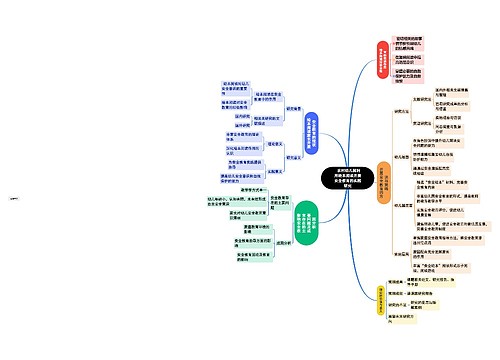
相似思维导图模版
首页
我的文件
我的团队
个人中心
